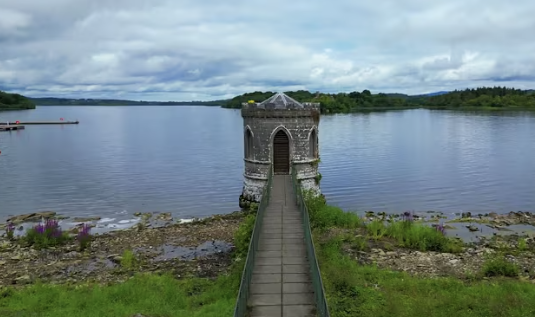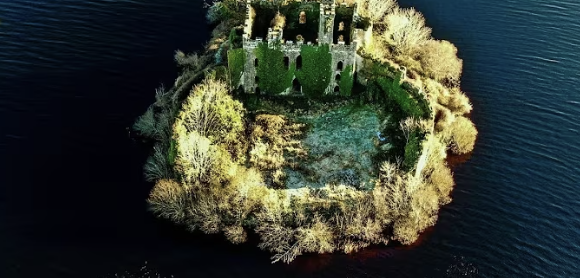McDermott's Castle stands as a captivating ruin on Castle Island in Lough Key, County Roscommon, Ireland. This small island fortress has a rich history dating back to the 12th century, when it was originally constructed by the McDermott clan. The castle's isolated location and crumbling stone walls create an air of mystery that continues to intrigue visitors today.

Over the centuries, McDermott's Castle witnessed numerous battles, sieges, and rebuilding efforts. Its strategic position made it a coveted stronghold, changing hands between various Irish clans and English forces. Despite suffering damage from fires and attacks, portions of the castle have endured, offering glimpses into its former grandeur.
Today, McDermott's Castle serves as a popular destination for history enthusiasts and photographers. While access to the island is limited, boat tours allow visitors to admire the ruins from the waters of Lough Key. The castle's picturesque setting and intriguing past make it a compelling subject for those interested in Irish heritage and medieval architecture.
What is the Historical Significance of McDermott's Castle?

McDermott's Castle holds a place of importance in Irish history due to its strategic location and centuries of varied ownership. The structure has witnessed numerous conflicts and power struggles since medieval times.
Origins and Early History
McDermott's Castle was built in the 12th century on Castle Island in Lough Key, County Roscommon. The McDermott clan, rulers of the kingdom of Moylurg, constructed the fortress as a defensive stronghold. Its island location provided natural protection against invaders.
The castle played a crucial role in local conflicts throughout the medieval period. In 1184, a lightning strike destroyed the original wooden structure. The McDermotts rebuilt it using stone, enhancing its durability and defensive capabilities.
Ownership Through the Centuries
The McDermott family maintained control of the castle for several centuries. Their reign ended in the 17th century during the Cromwellian conquest of Ireland. The castle then passed through various hands.
In 1654, the Cromwellian forces granted the castle to the King family. They held ownership until the late 18th century. The property later came under the control of the Rockingham estate.
By the early 19th century, the castle fell into disrepair. Despite its deterioration, it remained a significant landmark. In 1946, the Irish government took possession of the site as part of a larger land acquisition in the area.
Today, McDermott's Castle stands as a protected national monument. Its ruins continue to attract visitors interested in Irish history and architecture.
Geographical Location of McDermott's Castle
McDermott's Castle sits on a small island in a picturesque Irish lake. Its unique setting has made it a point of historical and tourist interest for centuries.
Lough Key

McDermott's Castle is located on Castle Island in Lough Key, County Roscommon, Ireland. Lough Key is a freshwater lake spanning approximately 300 hectares. The lake is part of the larger Lough Key Forest Park, a popular recreational area.
Castle Island is one of over 30 islands scattered across Lough Key. It stands out due to its man-made structures and historical significance. The island's area is roughly 0.2 hectares, making it one of the smaller islands in the lake.
The surrounding landscape includes woodlands, walking trails, and diverse wildlife habitats. This setting provides a scenic backdrop for the castle ruins.
Access to McDermott's Castle

Reaching McDermott's Castle requires boat transportation. Visitors can take guided boat tours from the Lough Key Forest Park marina. These tours typically operate during the summer months, weather permitting.
The boat journey to Castle Island takes about 10 minutes. Upon arrival, visitors can explore the island and castle ruins. Access to the interior of the castle is restricted for safety reasons.
For those preferring a view from afar, the castle is visible from several vantage points around Lough Key's shoreline. The Lough Key Forest Park offers walking trails and viewing areas that provide distant glimpses of the island castle.
The Architectural Description of McDermott's Castle
McDermott's Castle features a compact stone structure on a small island. The castle's design incorporates elements for defense and living quarters.
Main Castle Structure
The main castle building is a rectangular stone tower with thick walls. It stands three stories tall, with narrow windows on each level. The ground floor likely served as storage space, while upper floors contained living areas.
A crenellated parapet tops the tower, providing defensive positions. The entrance is located on the first floor, accessible by an external staircase. This design offered protection against potential attackers.
Inside, a spiral staircase connects the floors. The great hall, located on the second level, was the center of castle life. Stone fireplaces provided warmth and cooking facilities.
Surrounding Structures
A curtain wall encircles the island's perimeter, enhancing the castle's defenses. This wall stands approximately 2 meters high and 1 meter thick. It features intermittent watchtowers for improved surveillance.
A small harbor on the island's eastern side allowed for boat access. Remnants of a wooden jetty are still visible. Near the harbor, foundations of outbuildings suggest the presence of workshops and storage sheds.
A gatehouse guarded the main entrance to the castle complex. It likely included a drawbridge mechanism for controlling access to the island.
Cultural Impact of McDermott's Castle
McDermott's Castle has captured imaginations and left its mark on both folklore and popular culture. Its striking appearance and mysterious history have inspired various stories and artistic works.
Legends and Myths
Local tales often portray McDermott's Castle as a place of strange occurrences. One legend speaks of a ghostly woman in white who appears on moonlit nights, allegedly the spirit of a jilted lover seeking revenge.
Another myth claims the castle was built by fairies in a single night, explaining its sudden appearance on the island. Some fishermen report strange lights and sounds emanating from the ruins, fueling rumors of hidden treasures or ancient curses.
These stories have been passed down through generations, attracting curious visitors and paranormal enthusiasts to the site.
Representation in Media
McDermott's Castle has featured in several works of fiction and documentaries. Irish author W.B. Yeats mentioned the castle in his poetry, drawing inspiration from its romantic setting and historical significance.
The castle served as a backdrop for a popular Irish television drama in the 1990s, showcasing its picturesque ruins to a wider audience. Several documentary filmmakers have explored the castle's history and legends, presenting its story to international viewers.
In recent years, McDermott's Castle has gained attention on social media platforms, with photographers sharing stunning images of the ruins against the backdrop of Lough Key.
Current Status of McDermott's Castle
McDermott's Castle on Castle Island in Lough Key remains a picturesque ruin. The site continues to attract visitors and historians interested in its medieval architecture and storied past.
Conservation Efforts
The Office of Public Works oversees preservation of McDermott's Castle. Recent stabilization work focused on reinforcing crumbling walls and securing loose stonework. Archaeologists conducted surveys to document the castle's layout and construction techniques.
Vegetation management prevents further damage from tree roots and overgrowth. Regular inspections monitor the structure's condition and identify areas needing repair.
Local heritage groups advocate for increased funding to support more extensive restoration. Proposals include reconstructing fallen sections and adding protective roofing to shield interior spaces from the elements.
Public Access and Tourism
Castle Island is accessible by boat from the Lough Key Forest Park marina. Guided tours operate during summer months, providing historical context and legends associated with the site.
Safety barriers restrict entry to unstable areas. Visitors can explore the castle grounds and enjoy panoramic views of Lough Key.
The nearby Lough Key Forest Park offers complementary attractions, including walking trails, a visitor center, and recreational facilities. This helps draw tourists to the region and promotes awareness of McDermott's Castle.
Tourism officials market the castle as part of Ireland's Ancient East initiative, highlighting its connection to medieval Gaelic culture. Plans are underway to improve interpretive signage and develop immersive digital experiences to enhance visitor engagement.
Notable events occurred at McDermott's Castle.
Several significant events have occurred at McDermott's Castle over the centuries. In 1184, the castle proper was attacked and burned by the sons of Conchobar Maenmaige Ua Conchobair, causing considerable damage to the enclosure wall and the surrounding structures of the castle. This assault marked a dramatic chapter in the castle's history under the ruling dynasty of the time.
The castle changed hands multiple times throughout its history. In 1586, Queen Elizabeth I granted the castle and its surrounding lands to Sir Nicholas Malby. This transfer marked a shift in ownership from traditional Irish clans to English colonizers, symbolizing one of the distinct periods of its storied past.
A major restoration project took place in the 19th century. The McDermott family, descendants of the original builders, undertook extensive renovations to preserve the castle's historic character. This effort included work on features like the observation tower and two rooms, ensuring the structure's integrity for future generations.
In recent years, McDermott's Castle has become a popular tourist attraction. Visitors can explore the restored spaces, such as the underground tunnels, and learn about the site's rich history. The castle is set amidst scenic surroundings, including a bog garden and the tranquil waters of Loch Cé, adding to its charm. The nearby Trinity Bridge enhances access to the site, making it a hub for cultural events and educational programs. These efforts have highlighted the castle's ongoing significance, connecting it to both the upper and lower class experiences of its historical narrative.
Archaeological Findings at McDermott's Castle
Archaeological excavations at McDermott's Castle have yielded intriguing artifacts and structures. Surveys conducted in the early 2000s revealed remnants of medieval walls and foundations beneath the current ruins.
Pottery fragments dating back to the 12th century were unearthed during a 2015 dig. These pieces provide insights into the daily life of the castle's inhabitants and suggest continuous occupation over several centuries.
Researchers discovered a hidden chamber in 2018, containing well-preserved weapons and armor. This find indicates the castle's strategic military importance during its active years.
Metal detectorists working with archaeologists located numerous coins and personal items around the castle grounds. These objects span from the medieval period to the 19th century, illustrating the site's long history.
A notable discovery in 2022 was a series of underground passages connecting different parts of the castle. These tunnels likely served as escape routes or secret communication channels during times of siege.
Ongoing excavations continue to uncover new information about McDermott's Castle. Each finding adds to our understanding of its construction, layout, and the lives of those who called it home over the centuries.
Frequently Asked Questions About McDermott's Castle
1. What is the historical significance of McDermott's Castle?
McDermott's Castle holds importance as a medieval stronghold in Ireland. Built in the 12th century, it served as a defensive structure for the McDermott clan.
The castle witnessed several sieges and battles throughout its history. It played a role in local power struggles and conflicts between Irish clans.
2. Is McDermott's Castle open to the public for tours?
McDermott's Castle is not currently open for public tours. The island it sits on, Castle Island in Lough Key, is privately owned.
Visitors can view the castle ruins from boats on Lough Key. Some local tour operators offer boat trips that pass by the island.
3. Who is the current owner of McDermott's Castle?
The current owner of McDermott's Castle is a private individual. The identity of the owner is not publicly disclosed.
Ownership of the castle and island has changed hands several times over the centuries. It was last sold at auction in 2018.
4. Can you provide information on the architecture of McDermott's Castle?
McDermott's Castle features typical elements of medieval Irish castle architecture. The structure includes thick stone walls and a circular tower.
Much of the original castle is now in ruins. The remaining walls and foundations provide insights into its former layout and defensive design.
5. Is there a documented love story associated with McDermott's Castle?
A romantic legend is linked to McDermott's Castle. It tells of Una Bhan, daughter of the McDermott chief, and Tomás Laidir Ó Coscraigh.
Their tragic love story, set in the 16th century, has been immortalized in Irish folklore and poetry. It adds a layer of romantic intrigue to the castle's history.
6. What events led to the current state of McDermott's Castle?
The castle fell into disrepair over centuries of abandonment and neglect. It was damaged during conflicts in the 17th century.
Natural weathering and lack of maintenance contributed to its ruined state. Despite this, significant portions of the structure remain standing today.
